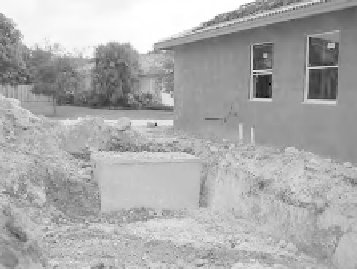Environmental Engineering Reference
In-Depth Information
precipitation
pumping well
evaporation
stream
confining unit
Figure 5.1.
Contaminant dispersion in groundwater.
grade level
access cover
(manhole)
access cover (manhole)
waste
inlet pipe
outlet pipe
effluent
scum
(from house)
(to tile bed)
Effluent
sludge
septic tank
(a)
(b)
Figure 5.2.
Septic tank. (a) Schematic diagram; (b) installed septic tank.
Source
: (a) Copyright © Carson Dunlop & Associates,
reproduced with permission.
Other constituents of concern in septic tank effluent
include bacteria, viruses, synthetic organics, and toxic
metals. Organic matter, BOD
5
, pathogenic microorgan-
isms, and phosphorus are effectively removed by most
properly designed and permitted septic tank systems,
and these contaminants are rarely found more than
1.5 m (5 ft) below the level of discharge or beyond the
immediate vicinity of the seepage field. The nitrification
process is typically completed in septic tank drainfields
located in well-drained soils, and the mobile nitrate-
nitrogen enters the groundwater.
Septic tanks are most likely to contribute to ground-
water contamination in areas where (1) there is a high
density of homes with septic tanks, (2) the soil is
extremely permeable, or (3) the water table is less than
1 m (3 ft) below the ground surface. Septic systems
perform poorly in undulating landscapes where the
hydraulic conductivity of the soil is low, and an imper-
meable soil layer is close to the surface. Under pro-
longed rainfall conditions on these soils, the septic field
and downslope field saturate, causing hydraulic failure
of the septic system and saturation of the downslope
field; as a result, effluent might be routed directly to
streams via overland runoff.
5.2.2 Leaking Underground Storage Tanks
Underground tanks store gasoline at service stations
and are widely used by various industries, agriculture,
and at homes to store oil, hazardous chemicals, and
chemical waste products. Leaks can be caused by rusting,
aging, and accidental puncturing of the tank, and these
leaks can go undetected for long periods of time. An
underground storage tank excavated at a gas station is




































































































































































































































































































































Search WWH ::

Custom Search